
The Overhead Press May Just Be the Best Pressing Movement Around

Whether you're a powerlifter, strongman, weightlifter, a CrossFitter, or bodybuilder, you know about the big three - the bench press, deadlift, and squat. There is, however, one more movement that you should consider a must-do - the overhead press. A staple in every strength sport, the overhead press has more aliases than Danny Ocean. You may know it as the shoulder press, strict press, military press, or standing press. Whatever you call it, the benefits remain the same: more upper-body strength, specific carryover to various strength sports, and bigger shoulders.
Like most exercises, the overhead press looks simple to execute but is more nuanced than it appears. Below, we'll walk you through every step for a proficient overhead press and go over the move's benefits, alternatives, and variations.
- How to Do the Overhead Press
- Common Overhead Press Mistakes to Avoid
- Overhead Press Vs. Shoulder Press Vs. Military Press
- Benefits of the Overhead Press
- Muscles Worked by the Overhead Press
- Who Should Do the Overhead Press
- Overhead Press Sets, Reps, and Programming Recommendations
- Overhead Press Variations
- Overhead Press Alternatives
- Frequently Asked Questions
Editor's note: The content on BarBend is meant to be informative in nature, but it should not be taken as medical advice. The opinions and articles on this site are not intended for use as diagnosis, prevention, and/or treatment of health problems. It's always a good idea to talk to your doctor before beginning a new fitness, nutritional, and/or supplement routine. None of these supplements are meant to treat or cure any disease. If you feel you may be deficient in a particular nutrient or nutrients, please seek out a medical professional.
Overhead Press Video Guide
In the video below, strength coach Joey Szatmary walks you through all of the tips and tricks you need for mastering this must-do strength and size-builder .
How to Do the Overhead Press
Below is a step-by-step guide on how to perform the overhead press using a barbell. Then below, we will discuss a wide variety of variations and alternatives to the overhead press.
Step 1 - Set Your Base

Set a barbell in the J hooks of a power rack so that the bar is level with your upper chest. Set your hands on the barbell so that they're sightly wider than shoulder width apart. You want the barbell to sit in the meat of your hands, or palms. Unrack the barbell, keeping your wrists stacked over your elbows, and your elbows tucked in.
Form Tip: Engage your upper back by retracting your shoulder blades and keeping your chest up.
Step 2 - Find Your Stance
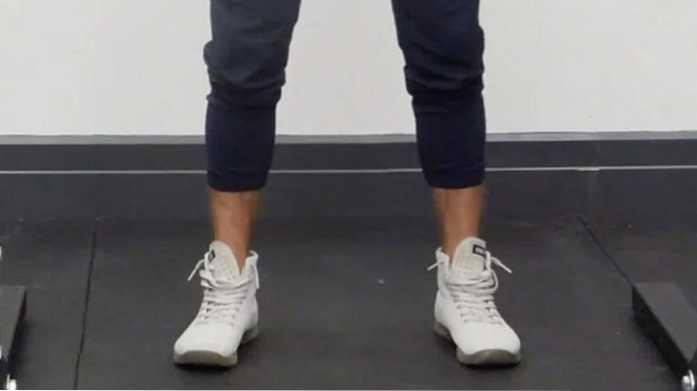
Take two steps back from the rack and set your feet are roughly shoulder-width apart. Grip the floor with your feet by pushing your knees out and twisting your feet outward (without actually moving them). You should feel your legs get tense. Feel free to play around with a different stance. Some lifters may prefer to stand with their feet closer together, for example.
Form Tip: Fully extend the knees and contract the glutes for added stability.
Step 3 - Tuck the Chin and Brace
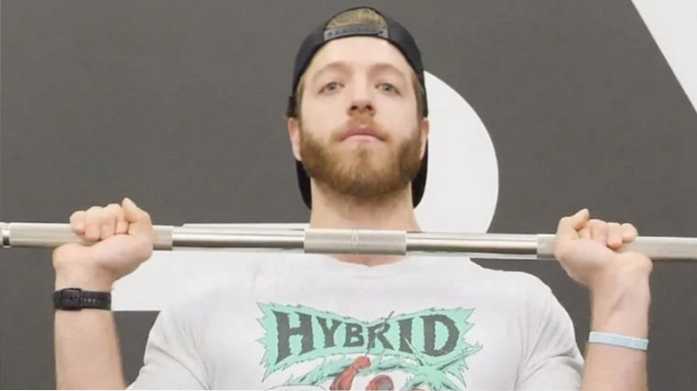
Before initiating the press, contract the lats, brace the abs, and tuck the chin. This position will allow you to generate more power because you're pressing from a stable base. Think about making a shelf with the lats and taking a belly breath that fills the obliques with pressure.
Form Tip: Keep the chest up, and head pulled back as if you were making a double chin.
Step 4 - Push Your Head Through the Barbell
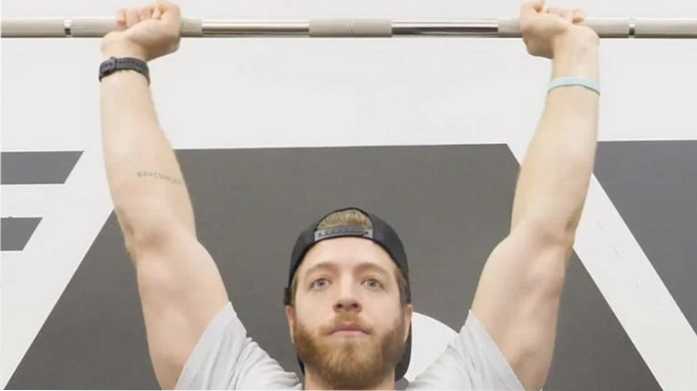
Press the barbell by keeping it positioned in the meat of the hands and driving it directly overhead. Once the barbell passes the head, contract the shoulders and shrug slightly to push you head through the bar. Ideally, you the bar to be positioned overhead in alignment with the mid-foot and heel. Lower the bar back down to the starting position with control.
Form Tip: Be sure to align the barbell over the midfoot, typically over the traps/back half of the head.
Common Overhead Press Mistakes to Avoid
The overhead press is a movement that comes with a lot of small moving parts, so here are a few do-nots to keep in mind as you're executing the movement.
Pressing Around the Head
The first overhead press mistake lifters can run into is pressing around the head, which is when one shifts the bar path to accommodate one's head position. Typically, shifting the bar path means the joins won't be stacked, and if they're not stacked on each other, you won't be as strong and stable.
- What It Looks Like: Pressing the bar in front of the body or bringing the barbell out and around the head.
- How to Fix It: Tuck the chin and video yourself from the side to ensure you're finishing with the barbell over the mid-foot or heel. This will ensure you're stacking the joints properly to achieve the most powerful positions possible.
Gripping the Bar Too Wide
Another common mistake is gripping the barbell too wide. A grip that is too wide can reduce your power output from the set as you're essentially taking the prime movers and putting them into disadvantageous positions.
- What It Looks Like: When in a front rack position, the arms will resemble a “W” with the body.
- How to Fix It: Bring the hands in to just outside of shoulder-width or where the hands are stacked over the elbows.
Assuming a Narrow Stance
A narrow stance can (a lot) of the time cause lifters to lose stability and balance, so bringing one's stance wider is often a better bet for success. Again, play around with this and pay attention to how you feel while pressing. A little narrow is OK, but you should feel grounded and strong.
- What It Looks Like: A stance with the feet hip-width apart or even touching.
- How to Fix It: Aim to achieve a stance that's between hip or just outside of shoulder width.
Overhead Press Vs. Shoulder Press Vs. Military Press
These are the three most common names for the overhead press, and, for the most part, they're virtually the same. That said, the press or shoulder press originated as a move in Olympic weightlifting. The movement standards weren't as strict, so lifters would drastically arch their back to hoist more weight. As time went on, the military press - a stricter, no-arch version of the move - was developed. Of course, most general gym-goers know that drastically arching the back during an overhead press can cause injury, so, for all intents and purposes, these moves are now virtually the same.
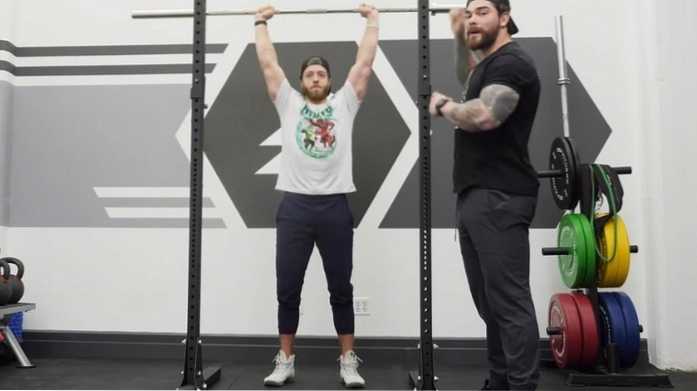
Benefits of the Overhead Press
There are a ton of reasons why you should be overhead pressing regularly. Below are four of our favorite reasons why the overhead press should be a staple in your training program.
Upper-Body Strength
In general, the overhead press is one of the best movements for obtaining upper body strength as a whole. Compared to other pressing movements, the overhead press will target the most muscles, translating to total body pressing strength. Outside of hitting the prime movers (the deltoids), the overhead press will also hit a plethora of stabilizers and synergist muscles.
Most Bang for Your Buck
If you're tight on time and need to cut your workout short, the overhead press should be at the top of your list. Since this movement targets so many muscles, it's a great option for lifters that want the most bang for their buck at the gym. As opposed to isolation pressing exercises which can be limited in nature, the overhead press has a much higher ceiling for total growth and progression. In short: Why target just your shoulders or triceps when you could hit your shoulders and triceps (and chest and upper back) with one movement?
Application to Strength Sports
If you compete in strength sports, especially strongman, weightlifting, and CrossFit, then you should be overhead pressing - even powerlifters can benefit from overhead pressing in their off-seasons. This movement will have carryover to total body strength when moving barbells overhead, a must for nearly every strength sport.
Muscles Worked by the Overhead Press
The below muscle groups are strengthened and trained during the barbell overhead press. Many of the same muscle groups are also targeted when performing the overhead press with kettlebells and dumbbells.
One small difference that comes with the overhead press than isolation exercises and other pressing variations is that it can be a fantastic movement for passively targeting the core. Though they're not mentioned below, the quads, glutes, and core muscles will all need to work to stabilize the body when moving weight from a dead stop position to overhead.
Shoulders (Deltoids)
The shoulders are the primary muscle group used when performing overhead pressing, specifically the anterior head of the deltoid.
Triceps
The triceps are responsible for elbow extension during the pressing movements. The triceps become more involved at later stages of the overhead press and aid in elbow lockout of the overhead press.
Upper Pecs
The upper pecs assist the shoulders and triceps in the pressing of the weight overhead, specifically during the initial phase of the lift. The greater degree of back extension (leaning backward) in the setup, increases upper pec usage (similar to that of an incline barbell press)
Scapular Stabilizers
Overhead pressing is dependent on scapular stability muscles to help create tension to support the shoulders, triceps, and upper pecs. Proper shoulder stabilization will also help position the barbell properly overhead and minimize injury compared to a more unstable scapular position.
Who Should Do the Overhead Press?
Below we will discuss what types of athletes can benefit from the overhead press and why.
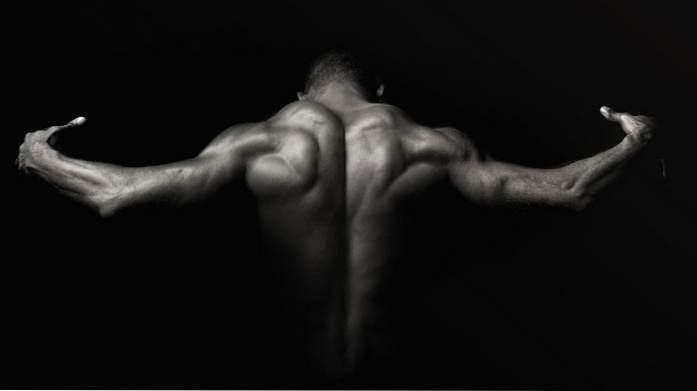
Strength and Power Athletes
Strength and power athletes use the renegade row to increase shoulder and upper body strength, muscle hypertrophy, and scapular stability.
- Powerlifters: The overhead press can be used to increase upper body strength and muscle mass. The same muscles responsible for overhead pressing often assist in the bench press, making this a good move to add diversity to your pressing abilities.
- Strongmen/Strongwomen: Strongmen and strongwomen perform overhead pressing movements in competition, making this exercise pattern key for developing the muscles needed to lift and support loads overhead.
- Olympic Weightlifters: Olympic weightlifters can use the overhead press to increase muscle growth and overhead pressing strength. Movements like the jerk can be assisted by adding in accessory lifts like overhead presses, push presses, and other pressing movements.
The General Population
For the same reasons listed above, any gym-goer can benefit from this movement. The overhead press will add more mass to your shoulders (if that's your goal), improve any other pressing movement in your repitore, and enhance your ability to reach overhead, which is a basic movement pattern that you engage in daily.
Overhead Press Sets, Reps, and Programming Recommendations
Below are three primary training goals and programming recommendations when programming the overhead press into workouts. Note that these are general guidelines and by no means should be used as the only way to program the overhead press.
To Gain Muscle
Training the overhead press for muscle hypertrophy should include a moderate to high volume with a moderate to high amount of loading. Try three to five sets of six to eight reps with a moderate to heavy load, or two to four sets of 12-15 reps with moderate loads to near failure. Keep rest periods 45-90 seconds.
To Gain Strength
Overhead presses can be programmed very similarly to most strength progressions. For strength, perform three to five sets of three to five repetitions with heavy loading, resting as needed.
To Improve Muscle Endurance
Some lifters may want to train greater muscle endurance (for sport), in which higher repetition ranges and/or shorter rest periods are recommended. While this can vary drastically in terms of loading, rest periods, and training volume (sets and reps), you can start by performing two to three sets of 20-30 repetitions with 45-60 second rest with light to moderate loads.
Overhead Press Variations
The overhead press is a highly technical movement and shouldn't be taken lightly when first learning its form. To help progress you to perfect presses, we recommend working with some overhead press variations below.
Dumbbell Overhead Press
The overhead press with dumbbells is a great first option for learning the overhead press. Dumbbells are slightly easier to work with when it comes to nailing form and joint sequencing required for the overhead press. The carryover won't be perfect to the barbell, but it's pretty close, and it's the concept of pressing that is the focal point with this progression.
Seated Overhead Press
Now that you've conquered the dumbbell press, it's time to move to the barbell. Before performing standing overhead presses, you can perform seated overhead presses to acclimate yourself to the barbell.
It's important to note that you definitely can progress to the traditional overhead press following dumbbells. Still, some lifters enjoy perfecting their seated overhead press, then working standing. It's a matter of preference in the learning of the press that should take control over exercise selection.
Shoulder Pin Press
This overhead press variation is done in a squat rack with a barbell resting on pins at the chin level. The starting height can vary based on the sticking point of your overhead press or area of weakness. This is a good way to develop concentric strength, address sticking points, and overload a specific angle for increased strength or emphasis on a muscle.
Overhead Press Alternatives
Below are three overhead press alternatives that can be done to increase power, strength, and hypertrophy or add variety to a training program.
Push Press
For more advanced lifters who have nailed their overhead press form, the push press with a barbell can be a great option for developing upper body strength and power. The push press entails many of the same movement mechanics as the overhead press but has you dip your legs for more momentum.
With the subtle dip to generate power, you can move more weight overhead, which is why strength athletes implement the push press into their regular training for power and strength goals.
Landmine Shoulder Press
Outside of performing the overhead press with dumbbells, the landmine press is another fantastic shoulder pressing variation for accumulating more volume. This variation is fantastic because it loads the shoulder joint differently from the directly overhead axial loading that comes with the standard overhead press.
For this reason, we love this variation for accruing additional training volume while mitigating stress on the shoulder joints. Progressively overload this variation by adding weight, reps, and tempo.
Z Press
The Z Press is a seated overhead press with dumbbells (or kettlebells or a barbell) that targets the upper body pressing muscles, along with the core and hips.
Since you're in a seated position while performing the Z Press, the body has to work exceptionally hard to stabilize itself for success. If you're trying to improve hip mobility, core strength, and pressing mechanics, then employ the Z Press into your shoulder workouts as an accessory. Start with dumbbells and progressively overload with weight, volume, and tempo.
FAQs
What muscles are worked with the overhead press?
The overhead press works a variety of muscles and is often referred to as one of the best movements for building a strong upper body. Some of the muscles the overhead press works include:
- Deltoids
- Scapular Stabilizers
- Upper Pec
- Triceps
In addition, the overhead press will work a variety of stabilizer muscles include the core, upper traps, and many more!
What's the difference between an overhead press and military press?
The overhead press and military press are both barbell pressing exercises, however, there's a tiny and subtle difference when referring to each with their respective definitions. The military press will entail positioning the feet close together, while the overhead press has a wider stance.
Can beginners overhead press with a barbell?
Yes, but it's a good idea to consult a coach or trainer. Of all the barbell compound movements, the overhead press can be slightly more complicated to nail perfectly when beginning barbell training, so the use of a coach can be a great tool to ensure technical proficiency.
If you don't want to hire a coach, then it's a great idea to try the overhead press with dumbbells first, and once you move to the barbell video sets to watch bar path and form.
Why should I do the overhead press?
The list of benefits that come with the overhead press will be individual per different athletes. Still, a few of the bigger benefits that come along with performing overhead presses with a barbell include:
- Carryover to strength sports and traditional sports.
- Improved overhead stability and strength.
- Targets multiple muscles at once.
- Fantastic for building a strong upper body with fewer variations, a.k.a. you get more juice for the squeeze!
How wide should my grip be for the overhead press?
There are two ways to scale grip width for more recreational lifters to get the most out of your form and potential power production.
When assessing grip width, check if it falls into the following range:
- Just outside of shoulder width.
- Wrists stacked over the elbows when in a rack position.
If you're wider than either of these, then there's a good chance you're gripping too wide!



Nimeni nu a comentat acest articol încă.